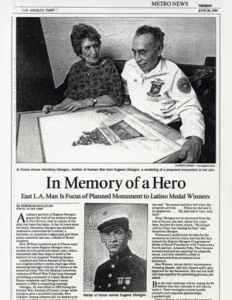 In Memory of a Hero
In Memory of a Hero
East L.A. Man Is Focus of Planned Monument to Latino Medal of Honor Recipients By Deborah Sullivan, Special to The Times. Los Angeles Times
A military portrait of Eugene Obregon graces the wall of his mother's house in Pico Rivera, next to a photo of the ship that bears his name. In the 44 years since his death, Henrietta Obregon has attended dedication ceremonies for a school, a barracks, an American Legion post and three parks named for her son, a Medal of Honor recipient.Now William Lansford and Al Flores want to turn the name Eugene Obregon into a symbol of civic pride and ethnic unity with a monument that they hope to build in his memory in Los Angeles' Pershing Square.
Lansford and Flores learned of the East Los Angeles soldier a dozen years ago while skimming through a history of Latinos in the armed services. The two Mexican American veterans of World War II had long dreamed of building a memorial to Latino Medal of Honor recipients, and Obregon's story seemed to offer a compelling message.Obregon, 19, was killed in 1950 during the Korean War, fending off enemy troops while trying to save a wounded comrade, Bert Johnson. Seeing Johnson fall, he dashed over and dragged him to the side of the road while continuing to fire at enemy troops, a Defense Department publication says.
Obregon was bandaging his friend's wounds when the platoon of enemy soldiers advanced on him. Seizing Johnson's carbine, "he placed his own body as a shield in front of him and (lay) there firing accurately and effectively into the hostile group until he himself was fatally wounded by enemy machine gun fire," the report says.
The monument that Flores and Lansford propose would be 20 feet high, with a bronze casting of Obregon guarding the injured Marine, atop a base of Mexican volcanic stone bearing the names of the other 37 Latino Medal of Honor recipients.
To another mother, this testimony to the last moments of her son's life might be a bittersweet tribute, but Henrietta Obregon said it evokes only pride.
"Oh, my gosh, that was really something. It's just beautiful," she said about the monument's design. "It makes me feel so proud."
Flores said they hope that the memorial will stir that feeling in others.
"One of the primary (reasons for the monument) is to build esteem for the Hispanic community," he said. "Right now, all you read about is shootings and drugs, whereas we have heroes that people should be aware about. We have 38 Hispanic Medal of Honor winners, most of whom gave their lives for the country."
Pete Valdez, another partner in the project, said, "It will create a bond - that we're all brothers, we're all one race, and there shouldn't be any divisions."
Obregon enlisted with four friends in 1948, straight out of Roosevelt High School. Although he was not yet 18, he was so determined to serve that he talked his mother into signing his enlistment papers. His sister, Virginia La Carra, remembers him as a friendly, popular kid who played baseball and soccer and liked to shadowbox and work on cars.
The bond between her and her brother ran deep, La Carra said, and she was the first to learn of his death. An ominous premonition preceded the dreaded telegram.
She woke up that day feeling inexplicably desolate. It was the morning of a cousin's wedding, but La Carra, distraught, refused to join her family for the reception.
"I was lying in bed, bawling my eyes out," she said. "No sooner had they left when the telegram arrived. . . . When my dad saw it, he passed out. . . . My dad took it very, very hard."
Peter Obregon never recovered from the loss of his son, she said. About five years later, he died of a heart attack. "He always told me Gene was waiting for him," said Henrietta Obregon.
Flores and Lansford put the idea for the memorial on hold for years, but last fall they formed the Eugene Obregon Congressional Medal of Honor Foundation with Valdez and a fourth partner, Armando Pena. They became incorporated and are applying for nonprofit status. And they solicited a sheaf of endorsements from prominent local politicians.
Rita Walters, whose district encompasses Pershing Square, said they should easily gain approval for the monument. She and her staff will help expedite the permitting process, she added.
But the real challenge will be raising the $1 million that they estimate it will take to build it. Their strategies include benefit concerts and corporate sponsorships, Lansford said.
Nelson Rising, an adviser to the memorial foundation and a senior partner at McGuire Thomas, a leader in the restoration of Pershing Square, said he does not expect them to have any problem obtaining corporate and community funding.
But Estella Romero, a marketing consultant for Latino and community issues who is helping with fund raising, cautioned that raising the money may be an uphill struggle.
"I regret to tell you that when it has come to a Latino project, it doesn't seem to be as important as other ventures, like the ballet or the philharmonic," she said.
The effort to create awareness of the war heroes is reminiscent of the battle for recognition that Latino soldiers waged 50 years ago. Determined to prove their loyalty, many Latino soldiers won respect by volunteering for the most dangerous assignments, Lansford said, and some sacrificed their lives defending others, as Obregon did.
"There was a lot of prejudice, especially in the Marine Corps, which was lily-white," Lansford said. "In the beginning we had to prove we could stick it out, but with all the Medal of Honor winners, through the war, we all became friends."
(© The Times Mirror Company; Los Angeles Times 1994, all Rights reserved)
